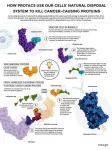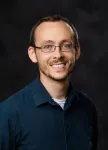(Press-News.org) Tumour protein P53 (TP53) plays an important role in suppressing the growth of tumours. Mutations in the gene for TP53 can have a disastrous effect, hampering the body's ability to fight tumours and even encouraging their growth. Because these are the most common mutations in cancers, TP53 has long been an interesting therapeutic target. However, efforts to destroy the mutant protein have been hampered by the difficulty of finding a way to bind to it.
Now, a team of researchers from Xi'an Jiaotong-Liverpool University (XJTLU) and other research institutes across China have published a study in which they engineered a short sequence of artificial DNA to target a particular mutant version of TP53. This mutation, called p53-R175H, is linked with lung, colorectal, and breast cancers, and tumours featuring the mutation are more likely to become resistant to chemotherapy treatments, such as cisplatin.
The new molecule, dp53m, is a proteolysis-targeting chimera (PROTAC), a type of molecule that consists of two components working together to recognise and degrade a target protein. In dp53m, the first component binds specifically to the mutant p53-R175H protein and does not interact with the non-mutant version of TP53. The second component engages an enzyme called ubiquitin ligase to break down the target mutated protein.
"The magic of PROTACs lies in their ability to recruit enzymes to the target protein, which then starts the process of breaking it down," says Dr Sijin Wu from the XJTLU Wisdom Lake Academy of Pharmacy.
Potential treatment
In their paper, published in Science Bulletin, Dr Wu and co-authors report the results of laboratory tests using dp53m against lung cancer cell cultures and in mice with cancer. The molecule inhibited the growth of cancer cells with the p53-R175H mutation while having no effect on cancer cells with other p53 mutations or with unmutated TP53.
Mice treated with dp53m had much lower levels of tumour growth than mice given a saline injection as a control. The mice also didn't lose weight, and their other organs were healthy, suggesting that the molecule is not toxic to healthy cells. The study also found that treatment with dp53m increased the sensitivity of mutant cancer cells to the chemotherapy agent cisplatin.
"The development of dp53m provides strong evidence for the feasibility of using short sequences of RNA or DNA as warheads for PROTACs," Dr Wu says. "It also could lead to a new potential therapeutic strategy for diseases associated with the p53-R175H mutation."
END
Engineered DNA 'warhead' targets a common cancer mutation
An engineered two-component molecule targets and destroys a mutant protein linked with numerous cancer types
2024-05-30
ELSE PRESS RELEASES FROM THIS DATE:
Picture this: Snapping photos of our food could be good for us
2024-05-30
New Curtin University research reveals taking pictures of food isn’t just content for our social media feeds, but could be the key to improving people’s diets.
Published in the prestigious American Journal of Clinical Nutrition, the feeding study saw researchers measure the weight of meals, which were then provided to participants over a day for breakfast, lunch and dinner.
Participants compared different technology-assisted methods to recall what they had eaten over the past 24 hours.
One method asked participants to take photos of their meals using the mobile Food Record app.
These ...
Portable pathology passes the test
2024-05-30
On-site pathology tests for infectious diseases in rural and remote locations can be just as reliable and accurate as tests carried out in a hospital laboratory, a new report from Flinders University shows.
Flinders University researchers tested the quality of on-site pathology testing, or Point-of-Care-Testing (POCT), for molecular-based, severe acute respiratory syndrome coronavirus 2 (SARS-CoV-2) detection in over 100 remote Aboriginal and Torres Strait Islander communities across Australia.
“Our study demonstrates that when point-of-care testing models are effectively established and managed, the quality of pathology results can be equivalent to ...
USC medical school dean appointed to CIRM board
2024-05-30
Carolyn C. Meltzer, MD, dean of the Keck School of Medicine of USC, has been appointed to the board overseeing the California Institute of Regenerative Medicine (CIRM). CIRM is the voter-created agency that funds stem cell research throughout the state.
“Stem cell research holds the tremendous promise to unlock health solutions that patients need,” said Steven D. Shapiro, MD, USC’s senior vice president for health affairs. “The CIRM board—and the people of our state—will benefit greatly from Meltzer’s wide-ranging leadership experience and place at the ...
Antibiotic pollution disrupts the gut microbiome and blocks memory in aquatic snails
2024-05-30
Antibiotics prevent snails from forming new memories by disrupting their gut microbiome - the community of beneficial bacteria found in their guts.
The new research, led by the University of East Anglia (UEA) in collaboration with Aberystwyth University, highlights the damaging effects that human pollution could be having on aquatic wildlife.
In the study, pond snails were given a favourite food – carrot juice – but had to quickly learn and remember that it was no longer safe to eat.
Snails ...
Researchers expose new symbiosis origin theories, identify experimental systems for plant life
2024-05-30
STARKVILLE, Miss.— A Mississippi State faculty member’s work on symbiosis—a mutually beneficial relationship between living organisms—is pushing back against the newer theory of a “single-origin” of root nodule symbiosis (RNS)—that all symbiosis between plant root nodules and nitrogen-fixing bacteria stems from one point—instead suggesting a “multiple-origin” theory of symbiosis which opens a better understanding for genetically engineering crops.
Ryan A. Folk, an assistant professor in the MSU Department of Biological Sciences and herbarium curator, is an author on a paper published this month in Nature ...
Q&A: How AI affects kids’ creativity
2024-05-30
Shortly after artificial intelligence models including Midjourney and OpenAI’s Dall-E went public, AI-generated art started winning competitions: one in digital art, another in photography. Concern rumbled that AI could replace artists — and even, by some metrics, be more creative than humans. But simultaneously, people were exploring these tools as ways to augment their creative processes, not replace them.
University of Washington researchers grew curious about how AI might affect creativity in children, specifically, so they worked with a group of 12 Seattle-area kids ages seven to 13 to explore how the kids’ creative processes interacted ...
Virtual lab meetings improve undergraduate research experience and foster diversity in academia
2024-05-30
Moisés A. Bernal, assistant professor in the Department of Biological Sciences at Auburn University, is collaborating with researchers Kathleen Lotterhos (Northeast University), Megan Phifer-Rixey (Drexel University), and Torrance Hanley, (Sacred Heart University) to evaluate the effectiveness of virtual lab meetings in demystifying the hidden curriculum in academia, incentivize primary research among students without previous experience, and foster participation of underrepresented groups in STEM.
The “Biological Practices” article entitled A virtual lab meeting training program mutually benefits mentees and host labs was recently published ...
Study shows effectiveness of updated COVID-19 vaccines wanes moderately over time, is lower against currently circulating variants
2024-05-30
May 29, 2024
Boosters that target the omicron subvariants of SARS-CoV-2 are still providing reasonably durable protection against infection, hospitalization and death from COVID-19, according to new data from a study led by researchers at the UNC Gillings School of Global Public Health.
Published today in the New England Journal of Medicine, the study found that COVID-19 boosters targeting the XBB.1.5 subvariants were most effective one month after receiving one. After four weeks, the vaccines were 52.2% effective at preventing infection and 66.8% effective at preventing hospitalization.
The vaccines were also highly effective ...
Researchers expose new ‘origin’ theories, identify experimental systems for plant life
2024-05-29
STARKVILLE, Miss.—A Mississippi State faculty member’s work on plant life symbiosis—a mutually beneficial relationship between living organisms—is pushing back against the newer theory of “single-origin”—that all life stems from one point—instead suggesting “multiple-origin” theory which opens a better understanding for genetically engineering crops.
Ryan A. Folk, an assistant professor in the MSU Department of Biological Sciences and herbarium curator, is an author on a paper published this month in ...
Researchers honored for outstanding contributions to cancer care
2024-05-29
Three Huntsman Cancer Institute researchers have recently been recognized for their work as outstanding faculty members at the University of Utah (the U).
Kim Kaphingst, ScD, director of cancer communication research at Huntsman Cancer Institute and professor of communication at the U, and June Round, PhD, investigator at Huntsman Cancer Institute and professor of microbiology and immunology at the U, were both granted the 2024 Distinguished Research Award. The faculty prize is given annually to scholars who exemplify exceptional research.
Kaphingst’s group explores cancer communication, particularly how to educate patients and families who ...
LAST 30 PRESS RELEASES:
Making lighter work of calculating fluid and heat flow
Normalizing blood sugar can halve heart attack risk
Lowering blood sugar cuts heart attack risk in people with prediabetes
Study links genetic variants to risk of blinding eye disease in premature infants
Non-opioid ‘pain sponge’ therapy halts cartilage degeneration and relieves chronic pain
AI can pick up cultural values by mimicking how kids learn
China’s ecological redlines offer fast track to 30 x 30 global conservation goal
Invisible indoor threats: emerging household contaminants and their growing risks to human health
Adding antibody treatment to chemo boosts outcomes for children with rare cancer
Germline pathogenic variants among women without a history of breast cancer
Tanning beds triple melanoma risk, potentially causing broad DNA damage
Unique bond identified as key to viral infection speed
Indoor tanning makes youthful skin much older on a genetic level
Mouse model sheds new light on the causes and potential solutions to human GI problems linked to muscular dystrophy
The Journal of Nuclear Medicine ahead-of-print tip sheet: December 12, 2025
Smarter tools for peering into the microscopic world
Applications open for funding to conduct research in the Kinsey Institute archives
Global measure underestimates the severity of food insecurity
Child survivors of critical illness are missing out on timely follow up care
Risk-based vs annual breast cancer screening / the WISDOM randomized clinical trial
University of Toronto launches Electric Vehicle Innovation Ontario to accelerate advanced EV technologies and build Canada’s innovation advantage
Early relapse predicts poor outcomes in aggressive blood cancer
American College of Lifestyle Medicine applauds two CMS models aligned with lifestyle medicine practice and reimbursement
Clinical trial finds cannabis use not a barrier to quitting nicotine vaping
Supplemental nutrition assistance program policies and food insecurity
Switching immune cells to “night mode” could limit damage after a heart attack, study suggests
URI-based Global RIghts Project report spotlights continued troubling trends in worldwide inhumane treatment
Neutrophils are less aggressive at night, explaining why nighttime heart attacks cause less damage than daytime events
Menopausal hormone therapy may not pose breast cancer risk for women with BRCA mutations
Mobile health tool may improve quality of life for adolescent and young adult breast cancer survivors
[Press-News.org] Engineered DNA 'warhead' targets a common cancer mutationAn engineered two-component molecule targets and destroys a mutant protein linked with numerous cancer types






